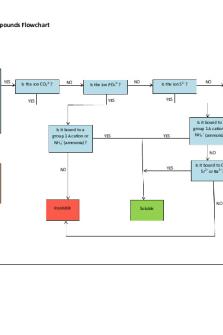Solubility Rules PDF

| Title | Solubility Rules |
|---|---|
| Course | General Chemistry 1 |
| Institution | Broward College |
| Pages | 1 |
| File Size | 58.7 KB |
| File Type | |
| Total Downloads | 65 |
| Total Views | 135 |
Summary
This is a summary of the solubility rules for chemicals...
Description
Solubility Rules In principle, all ionic compounds dissolve in water to some extent, though this may be very slight. For practical purposes, we consider a compound to be insoluble if the maximum amount that can dissolve is less than about 0.01 mole per liter. To predict the solubility of different ionic compounds, we can use a set of approximate solubility rules as follows. I.
Compounds that are always soluble: – Those that contain alkali metal cations (Li+, Na+, K+, Rb+, Cs+) or the ammonium ion (NH4+). – Those that contain the anions nitrate (NO3 G), perchlorate (ClO4 G), or acetate (C2H3O2 G).
II. Compounds that are usually soluble: – Those that contain chloride, bromide, or iodide ions. Exceptions: salts containing Pb2+, Ag+, or Hg22+ are insoluble. – Those that contain sulfate (SO4 2G). Exceptions: salts containing Sr2+, Ba2+, Pb2+, Hg2 2+. CaSO4 is slightly soluble. III. Compounds that are mostly insoluble: – Those that contain sulfide (S2G). Exceptions: salts containing NH4 + or the grou p I and II cations are soluble. – Those that contain hydroxide (OHG). Exceptions: salts containing NH4 + or the group I and II cations (except Be2+ and Mg2+) are soluble. – Those that contain carbonate (CO3 2G) or phosphate (PO43G). Exceptions: salts containing NH4+ or the group I cations are soluble.
These rules are taken from “General Chemistry Principles and Modern Applications 8'th Ed.,” Petrucci, Harwood, and Herring, Prentice Hall, Upper Saddle River, NJ 2002....
Similar Free PDFs

Solubility Rules
- 1 Pages

Solubility Rules
- 1 Pages

Solubility Rules
- 1 Pages

Solubility rules - Exam Prep
- 1 Pages

27 Solubility-S - Solubility
- 4 Pages

Solubility Guidelines
- 1 Pages

Log rules logarithm rules
- 7 Pages

Predicting Solubility
- 1 Pages

Solubility Flowchart
- 2 Pages

Solubility Table
- 1 Pages

Solubility Equilibrium
- 8 Pages
Popular Institutions
- Tinajero National High School - Annex
- Politeknik Caltex Riau
- Yokohama City University
- SGT University
- University of Al-Qadisiyah
- Divine Word College of Vigan
- Techniek College Rotterdam
- Universidade de Santiago
- Universiti Teknologi MARA Cawangan Johor Kampus Pasir Gudang
- Poltekkes Kemenkes Yogyakarta
- Baguio City National High School
- Colegio san marcos
- preparatoria uno
- Centro de Bachillerato Tecnológico Industrial y de Servicios No. 107
- Dalian Maritime University
- Quang Trung Secondary School
- Colegio Tecnológico en Informática
- Corporación Regional de Educación Superior
- Grupo CEDVA
- Dar Al Uloom University
- Centro de Estudios Preuniversitarios de la Universidad Nacional de Ingeniería
- 上智大学
- Aakash International School, Nuna Majara
- San Felipe Neri Catholic School
- Kang Chiao International School - New Taipei City
- Misamis Occidental National High School
- Institución Educativa Escuela Normal Juan Ladrilleros
- Kolehiyo ng Pantukan
- Batanes State College
- Instituto Continental
- Sekolah Menengah Kejuruan Kesehatan Kaltara (Tarakan)
- Colegio de La Inmaculada Concepcion - Cebu




